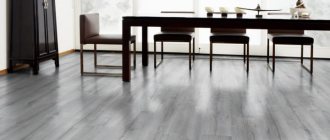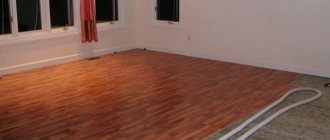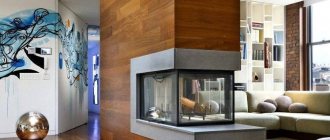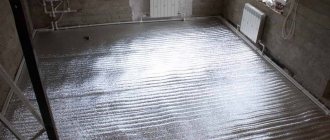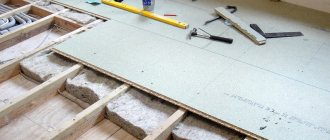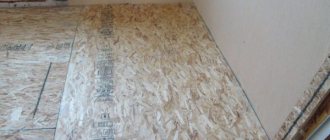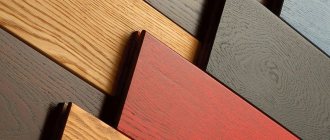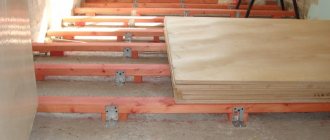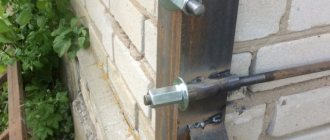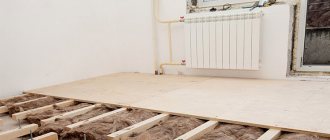Penoplex is an insulation material that is often used in construction to insulate surfaces, including when laying laminate flooring. This heat insulator is very popular due to its strength and moisture resistance.
Before use, it is recommended to carefully familiarize yourself with the characteristics of the material, as well as the features and technology of laying penoplex under the laminate.
Why choose penoplex?
The popularity of penoplex is due to a number of important advantages:
- Fine cell structure . The presence of many cells increases the effectiveness of penoplex, aimed at retaining heat in the room.
- Moisture resistance . This property is maintained even with prolonged use of the heat insulator. Thanks to its ability to resist fungi and mold, penoplex retains its performance and characteristics for a long time.
- High level of strength . Penoplex has an increased compression resistance. Thanks to this property, sagging of the laminate can be prevented.
- Compatible with underfloor heating system . Contact with hot surfaces does not negatively affect the performance of the insulation. The exception is temperatures above 80 degrees. In this case, deformation of the heat insulator and partial or complete loss of its properties is possible.
- Fire resistance . Thanks to this property, penoplex can be used in wooden houses.
- Versatility . Penoplex is used for insulating floors placed on the ground, above basements, on floors, balconies and loggias. In any conditions, the material is able to provide an optimal level of comfort for people to live in.
- Relatively low cost.
Due to its characteristics, penoplex can be effectively combined with laminate of any thickness.
When choosing penoplex for laying laminate, it is important to consider that this heat insulator loses its properties under the influence of ultraviolet radiation and has lower sound insulation rates than other heat insulators, for example, fiberglass or mineral wool.
Technical characteristics of penoplex of different brands
| Penoplex brand, properties | 31 | 31С | 35 | 45.45С |
| Density (kg/m3) | 28-30.5 | 25-30.5 | 28-37 | 35-45 |
| Compressive Strength(MPa) | 0.20 | 0.20 | 0.21 | 0.41 – 0.50 |
| Flexural strength (MPa) | 0,25 | 0,25 | 0,4 | 0.4-0,7 |
| Water absorption coefficient, % | 0.4 | 0.4 | 0.4 | 0.2 – 0.4 |
| Fire hazard | G4 | G1 | G1 | G4 |
Video: Laying laminate flooring on penoplex - without screed
Penoplex has many positive properties and high performance characteristics. Therefore, novice builders assume that it can be installed without it. In reality, this opinion is incorrect, but although the video shows how to do it.
What insulation is better to put under laminate
You can insulate the floor under the laminate in your home using different materials. When choosing, a number of factors are taken into account, including the complexity of the work, its costs, and the expected effect.
Expanded clay
Expanded clay is a bulk building material. It is made from low-melting clay by firing.
This insulation has many advantages:
- low price;
- lightness due to the porous structure;
- maximum filling of space;
- strength;
- durability;
- fire resistance;
- no toxicity;
- resistance to low temperatures, fungi;
- reduction in screed weight.
Thanks to these properties, expanded clay is suitable not only for residential premises, but also for insulating floors on balconies under laminate. The material can be added to concrete or used in other ways:
- Dry screed. This option is used for concrete floors. A layer of expanded clay is poured, then a screed is made, a substrate is laid and the laminate is laid.
- Insulation with logs. The beams are installed, expanded clay is poured between them, fiberboard or chipboard is laid on top, and the laminate is laid on the substrate.
For insulation and leveling the floor, expanded clay with a fraction of 5-10 mm is better - it is called gravel. Note! You should work with expanded clay using a respirator. This is only dust protection, the material is safe for health.
Foil and glass wool
Glass wool is a type of mineral wool made from molten glass. The material can be rolled or in the form of plates. It has good thermal insulation and other advantages:
- high elasticity, chemical resistance;
- low price;
- ease;
- durability;
- lack of flammability;
- continuous coating;
- good sound insulation;
- no susceptibility to fungi or mold.
The disadvantages of glass wool include unsafe operation and shrinkage, which increases when moistened. High-quality insulation should restore its original appearance when deformed.
It is better to use glass wool with a layer of foil. This allows you to reduce the thickness of the insulation layer. Place the material between the joists, then lay chipboard or plywood.
Floor foil can be used in rolls or slabs. The material has several advantages:
- good thermal insulation - up to 95-97% of thermal radiation is reflected into the room;
- long service life;
- resistance to moisture;
- noise absorption;
- environmental friendliness;
- elasticity.
It is important to correctly place the foil insulation under the laminate. The reflective side should be directed into the room.
Foil mineral wool is often used for non-residential premises. The material is not afraid of temperature changes and is not flammable. It can be used on uneven and curved surfaces. The thickness of foiled glass wool is usually 5-10 cm.
Foil glass wool is laid with the reflective side up; no additional vapor barrier is required
Styrofoam
Polystyrene foam is a foamed plastic mass. It has many advantages:
- thermal insulation;
- sound absorption;
- low cost;
- ease of processing and installation;
- light weight.
Polystyrene foam can be used to insulate the floor on a loggia or balcony under laminate, and can be used in residential premises. The material is not afraid of moisture or temperature changes. There are several options for using insulation:
- Foam boards for screed. Make a small layer on top of the foam panels laid on the concrete floor. After drying, proceed to finishing with laminate.
- Adding granular foam to concrete mortar. Uniform distribution of insulation is important.
- Laying foam boards between joists. For ease of installation, the interval between the beams must correspond to the dimensions of the insulation. After placing it, shields are installed on the logs, then they begin laying the laminate.
- Liquid foam plastic (penoizol). It is placed between the logs, after drying the mass becomes porous. The material is not hygroscopic, not susceptible to rodents, fungi, mold.
Comment! You need to work with penoizol in special clothing, using a respirator, gloves and goggles. Harmful substances are released only before polymerization, after which the material is safe.
Penoizol has higher thermal insulation than classic polystyrene foam and mineral wool
Coniferous slabs
Such boards are an environmentally friendly material - no glue, modifiers, or other additives are used in their production. They have several advantages:
- thermal insulation;
- sound absorption;
- masking small irregularities;
- low cost;
- ease of installation processing.
Coniferous underlay under laminate can be used as insulation for both wooden and concrete floors. There is no need to fix the boards with glue.
The coniferous substrate is a breathable material, therefore it allows moisture to pass through without accumulating it. The downside is that this property does not prevent the formation of mold. Coniferous boards should not be used in rooms with high humidity. It is important to lay them on a completely dry surface.
Coniferous slabs are laid diagonally; if desired, tape can be used for fixing
Cork substrates
Cork backing for laminate can be sheet or roll. The color of the material is usually light brown. The advantages are as follows:
- thermal insulation;
- wear resistance;
- durability;
- ease of processing and installation.
The cork backing can be natural or synthetic rubber. There is an option based on kraft paper with the addition of bitumen and spraying of fine cork shavings.
Comment! Cork underlayment is not suitable for heated floors. Due to temperature changes, it will shrink and swell and quickly collapse.
Among the disadvantages of cork substrate is hygroscopicity - if moisture gets in, mold may appear.
Laying with concrete screed
When laying penoplex under a laminate with a concrete screed, first of all it is necessary to level the floor surface. Only after this can you begin laying out the heat insulation slabs and waterproofing material. In this way, it will be possible to prevent the penetration of moisture from the sand-cement screed into the joints.
The next stage is the uniform distribution of the pre-prepared concrete mixture over the entire surface of the waterproofing. It is recommended to use a self-leveler.
Thus, the composition will independently distribute itself evenly over the surface, providing a perfectly flat base for further laying of the laminate. This measure will significantly extend the service life of the coating. The substrate and laminate are installed after the composition has completely dried.
When using cement screed, it is recommended to use slabs with grooves at the ends. They will provide tighter joints.
If you plan to install heated floors, it is recommended to follow a number of tips:
- Installation should be carried out using special technology provided for such cases.
- When choosing a heated floor, give preference to a water-type system. Electrical structures have the ability to quickly warm up, which negatively affects the condition of the penoplex.
- When using an electric floor heating system, install thermostats to progressively increase and decrease the heating temperature. This will preserve the suitability of the thermal insulator for a long time.
Polyethylene or polystyrene?
There is an interesting confusion in life: due to the fact that foamed polystyrene and polyethylene are classified as foam plastic, professional builders often confuse them. However, these are completely different materials, with different characteristics and, naturally, prices.
Foamed polyethylene can be cross-linked (abbreviated PPE) and non-cross-linked (NPE). Both types of material (Izolon, Stenofon, Porilex) have the lowest price among substrates (15-28 rub./m2). But this does not mean that they are of equally low quality.
Non-crosslinked polyethylene foam (NPE) does not have a cross-linking network at the molecular level, which leads to rupture of the material under significant loads. In cross-linked polyethylene (XPE), the hydrogen atom is replaced by a carbon atom during the manufacturing process, resulting in the formation of molecular bonds in all directions (hence cross-linked). This polyethylene significantly exceeds NPE in all indicators:
- density - 30% higher;
- strength - 40-50% higher;
- long service life - almost 2 times longer;
- high level of sound insulation (NPE has practically none);
- thermal conductivity - 20% lower.
However, cross-linked polyethylene foam is still slightly inferior in quality to the polystyrene substrate, which is reflected in the price. For expanded polystyrene it is in the range of 35-50 rubles/m2.
Conclusion: based on prices and quality characteristics, PPE is the best foam backing for linoleum. For budget renovations, it is better to lay expanded polystyrene under laminate or parquet.
Laying with dry screed
The procedure for laying penoplex under laminate with a dry screed is much simpler than with concrete and requires less time. At the first stage of work, it is necessary to place wooden logs.
Penoplex should be laid in between them. The height of the logs must match the thickness of the thermal insulator. Thus, the entire resulting load will be evenly distributed between the screed and the insulation.
Plywood, gypsum fiber boards (GVL) and other suitable materials are used as dry screeds.
The thickness of the plywood should depend on the distance between the joists. The larger it is, the thicker the screed should be. This will prevent the laminate from bending in the future. When laying plywood, it is important to carefully check the level of the surface. The final stage of work is laying the underlay and flooring.
Deformation of the laminate can lead to damage to the locks of the floor covering and loss of its appearance.
When choosing a dry screed, it is recommended to use a heat insulator without a curved edge.
Characteristics of extruded polystyrene foam
How to lay laminate correctly
Most often, underlays made from this particular material are used under the laminate. The peculiarity of its structure lies in evenly spaced closed cells, which ensures the moisture resistance of the material. The substrate is manufactured using an extrusion molding machine, where polystyrene along with a foaming agent is fed through a narrow nozzle under high pressure and high temperatures. The result is a material with low density (30-40 kg/m³).
Expanded polystyrene backing
Grooves on one side of the substrate are necessary for natural air circulation
The material does not rot and does not absorb moisture. When wet, water does not penetrate further than the open side honeycombs at the cut. It is distinguished from its analogues by its greater strength and thermal insulation properties. Substrates made from this material are produced in rolls and in the form of sheets, measuring 1000 x 500 x 3 mm.
Table 2. Characteristics of polystyrene foam
| Technical properties | Unit | Meaning |
| Moisture absorption | % | 0.08 |
| Operating temperature range | °C | from -50 to +75 |
| Density | kg/m³ | 35 |
| Soundproofing | dB | from 5.5 to 22 |
| Thermal conductivity | W/(m*°С) | 0.035 |
Polystyrene foam substrates combine high quality and affordable price
Substrate and penoplex
During installation work, it is important not to confuse penoplex and the substrate, which can be cork or polyethylene. The task of the latter is to prevent the penetration of noise and moisture.
The substrate itself is not capable of preventing the destruction of penoplex. This function is performed by the screed. Therefore, during installation work you should not deviate from the technologies developed by specialists.
It is important to adhere to the established rules and use all structural elements: penoplex, screed, substrate and laminate. In addition, it is forbidden to violate the order of laying the listed components.
Only if the technology is followed will it be possible to obtain a beautiful, reliable and warm floor that can last for many years. Otherwise, within six months, new repairs will be required to correct the mistakes made.
When can you do without it?
- the laminate is laid over chipboard/fibreboard and attached to them with self-tapping screws - they will still cut through the waterproofing, so there is no point in laying it down;
- laminate flooring is installed in an apartment of an apartment building, not on the ground floor, where people live all year round and there is centralized heating (or other heat sources that work in cold weather);
- there is a wooden floor under the laminate - in this case, waterproofing is needed already under the wooden floor (because if moisture gets on the wood from below, the laminate will survive, but the wood underneath will rot).
Floor without joists
Laying penoplex without joists is allowed only on a perfectly flat and smooth floor without any protrusions. Plywood is laid on polystyrene foam in two overlapping layers. Both tiers are fastened with self-tapping screws. Particular attention should be paid to seam areas. The result should be an almost monolithic slab capable of withstanding high uneven loads.
This technology requires careful selection of plywood. If it is not thick enough, sags may form in areas of high pressure over time.
Ground installation: step by step
The design thickness of such a floor cake is 60-70 cm. The base must be dry and thoroughly compacted.
- A layer of gravel 30 cm or more thick is laid alternately with a layer of fine sand about 10 cm thick - both layers must be thoroughly compacted.
- Carefully level the installation location.
- They are alternately covered with expanded clay and sand to a height of 40 cm.
- Then thermal insulation boards with a thickness of 5 cm or more are laid. The insulation sheets are neatly connected without gaps. The joints are sealed with adhesive tape. Penoplex is suitable for the first floor.
- The entire base is covered at the edges with tarred paper (roofing felt) or polyethylene. They are mounted on penoplex.
- Then a metal mesh is laid for reinforcement and the whole thing is filled with concrete. The layer thickness must be at least 5 cm.
- To avoid problems when laying the floor, the pouring is carefully leveled over the entire pouring plane.
Video: DIY ground floors
Insulation of wooden floors
Insulation of a wooden floor is allowed only if the boards are in good condition.
In addition to penoplex, the following tools and materials will be required for work:
- building level;
- hammer;
- grinding wheel;
- screwdriver;
- self-tapping screws;
- primer with an antiseptic composition;
- vapor barrier;
- plywood;
- Chipboard or OSB.
Algorithm for insulating a wooden floor:
- Remove baseboards and top covering.
- Check the quality of the boards. If mold, black spots, insect damage or other imperfections are found, the damaged boards must be replaced. If there are no flaws, you need to return the boards to their original place and check their horizontal position.
- Level the wooden surface using a grinding wheel, fill all existing cracks and recesses with wood putty.
- Treat wooden surfaces with an antiseptic primer. Wait until completely dry. If the wood is too porous, it is recommended to repeat this procedure 2 - 3 times.
- On a dry surface, lay out the foam boards in a spaced pattern and secure them with glue. Foam all the resulting gaps. It is important to take into account that toluene has a destructive effect on penoplex. Therefore, you should choose a foam that does not contain this component.
- Lay the vapor barrier overlapping by 10 centimeters so that its edges slightly overlap the walls. In the future, all excess material must be removed.
- Lay a layer of plywood or chipboard so that the seams do not meet in one place. During work, it is important to control the surface level. It should be perfectly smooth.
- Lay the underlay and lay the laminate.
Video: Insulating a wooden floor with penoplex over joists
Many craftsmen recommend using logs to insulate wooden floors. But in this case, such important properties of penoplex as moisture resistance and strength lose their relevance. Therefore, to insulate a wooden floor using logs, it is advisable to use cheaper materials, for example, mineral wool or polystyrene foam.
When laying laminate flooring as insulation, it is important to choose a material that has high performance characteristics. One of the best options is penoplex. Due to its structure, it has high thermal insulation properties. If the technology and all the listed rules are followed when installing the coating, the floor will remain smooth, beautiful and warm for a long time.
Flaws
The main disadvantage of the insulation was the inability to hide existing unevenness with its help. If their size exceeds one centimeter, a laminate floor with such a substrate will quickly lose its relief and begin to creak when walking.
Another disadvantage is the packaging of the material. It is not sold in parts; you have to purchase extra material, which certainly leads to financial losses.
Packaging of polystyrene foam material
